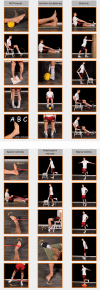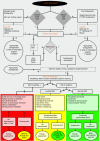Acute ankle sprain in athletes: Clinical aspects and algorithmic approach
- PMID: 33362991
- PMCID: PMC7745493
- DOI: 10.5312/wjo.v11.i12.534
Acute ankle sprain in athletes: Clinical aspects and algorithmic approach
Abstract
Acute ankle sprain is the most common lower limb injury in athletes and accounts for 16%-40% of all sports-related injuries. It is especially common in basketball, American football, and soccer. The majority of sprains affect the lateral ligaments, particularly the anterior talofibular ligament. Despite its high prevalence, a high proportion of patients experience persistent residual symptoms and injury recurrence. A detailed history and proper physical examination are diagnostic cornerstones. Imaging is not indicated for the majority of ankle sprain cases and should be requested according to the Ottawa ankle rules. Several interventions have been recommended in the management of acute ankle sprains including rest, ice, compression, and elevation, analgesic and anti-inflammatory medications, bracing and immobilization, early weight-bearing and walking aids, foot orthoses, manual therapy, exercise therapy, electrophysical modalities and surgery (only in selected refractory cases). Among these interventions, exercise and bracing have been recommended with a higher level of evidence and should be incorporated in the rehabilitation process. An exercise program should be comprehensive and progressive including the range of motion, stretching, strengthening, neuromuscular, proprioceptive, and sport-specific exercises. Decision-making regarding return to the sport in athletes may be challenging and a sports physician should determine this based on the self-reported variables, manual tests for stability, and functional performance testing. There are some common myths and mistakes in the management of ankle sprains, which all clinicians should be aware of and avoid. These include excessive imaging, unwarranted non-weight-bearing, unjustified immobilization, delay in functional movements, and inadequate rehabilitation. The application of an evidence-based algorithmic approach considering the individual characteristics is helpful and should be recommended.
Keywords: Ankle sprain; Athlete; Exercise therapy; Rehabilitation; Return to play; Sport injury.
©The Author(s) 2020. Published by Baishideng Publishing Group Inc. All rights reserved.
Conflict of interest statement
Conflict-of-interest statement: The authors declare no conflict of interest.
Figures



Similar articles
-
Treatment of acute lateral ankle ligament rupture in the athlete. Conservative versus surgical treatment.Sports Med. 1999 Jan;27(1):61-71. doi: 10.2165/00007256-199927010-00005. Sports Med. 1999. PMID: 10028133 Review.
-
Acute Ankle Sprain in Elite Athletes: How to Get Them Back to the Game?Foot Ankle Clin. 2023 Jun;28(2):309-320. doi: 10.1016/j.fcl.2022.12.007. Epub 2023 Mar 1. Foot Ankle Clin. 2023. PMID: 37137625 Review.
-
First-time inversion ankle ligament trauma: the effects of sex, level of competition, and sport on the incidence of injury.Am J Sports Med. 2005 Oct;33(10):1485-91. doi: 10.1177/0363546505275490. Epub 2005 Jul 11. Am J Sports Med. 2005. PMID: 16009979
-
Effects of balance training on post-sprained ankle joint instability.Int J Risk Saf Med. 2015;27 Suppl 1:S99-S101. doi: 10.3233/JRS-150707. Int J Risk Saf Med. 2015. PMID: 26639734
-
Acute ankle sprain: an update.Am Fam Physician. 2006 Nov 15;74(10):1714-20. Am Fam Physician. 2006. PMID: 17137000 Review.
Cited by
-
Cryo plus Ultrasound Therapy, a Novel Rehabilitative Approach for Football Players with Acute Lateral Ankle Injury Sprain: A Pilot Randomized Controlled Trial.Sports (Basel). 2023 Sep 9;11(9):180. doi: 10.3390/sports11090180. Sports (Basel). 2023. PMID: 37755857 Free PMC article.
-
Design and Experimental Research of 3-RRS Parallel Ankle Rehabilitation Robot.Micromachines (Basel). 2022 Jun 16;13(6):950. doi: 10.3390/mi13060950. Micromachines (Basel). 2022. PMID: 35744564 Free PMC article.
-
Comparison of spring ankle braces versus splints and casts in treating ankle sprains in patients diagnosed with ankle sprains.BMC Musculoskelet Disord. 2024 Oct 4;25(1):786. doi: 10.1186/s12891-024-07901-4. BMC Musculoskelet Disord. 2024. PMID: 39367359 Free PMC article.
-
Lisfranc Sports Injuries: What Do We Know So Far?Cureus. 2023 Nov 13;15(11):e48713. doi: 10.7759/cureus.48713. eCollection 2023 Nov. Cureus. 2023. PMID: 37965234 Free PMC article. Review.
-
A test battery for evaluation of muscle strength, balance and functional performance in subjects with chronic ankle instability: a cross-sectional study.BMC Sports Sci Med Rehabil. 2023 Apr 13;15(1):55. doi: 10.1186/s13102-023-00669-5. BMC Sports Sci Med Rehabil. 2023. PMID: 37055818 Free PMC article.
References
-
- Boruta PM, Bishop JO, Braly WG, Tullos HS. Acute lateral ankle ligament injuries: a literature review. Foot Ankle. 1990;11:107–113. - PubMed
-
- Gribble PA, Bleakley CM, Caulfield BM, Docherty CL, Fourchet F, Fong DT, Hertel J, Hiller CE, Kaminski TW, McKeon PO, Refshauge KM, Verhagen EA, Vicenzino BT, Wikstrom EA, Delahunt E. Evidence review for the 2016 International Ankle Consortium consensus statement on the prevalence, impact and long-term consequences of lateral ankle sprains. Br J Sports Med. 2016;50:1496–1505. - PubMed
-
- Waterman BR, Owens BD, Davey S, Zacchilli MA, Belmont PJ Jr. The epidemiology of ankle sprains in the United States. J Bone Joint Surg Am. 2010;92:2279–2284. - PubMed
-
- Ruth CJ. The surgical treatment of injuries of the fibular collateral ligaments of the ankle. J Bone Joint Surg Am. 1961;43:229–239.
Publication types
LinkOut - more resources
Full Text Sources
Medical

